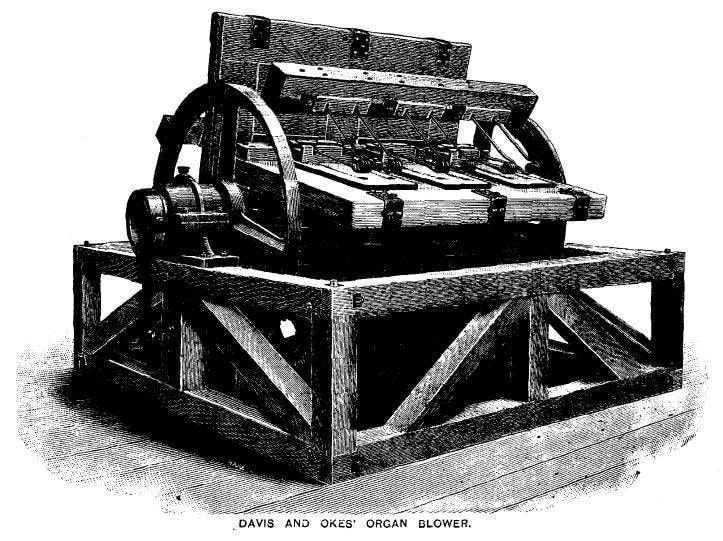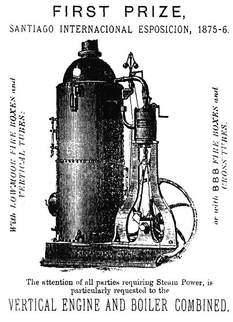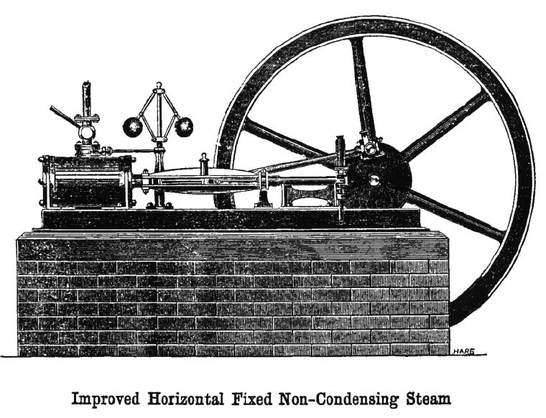Hydraulic blowers gave excellent service: it is said that numbers are still in use in parts of the USA where local water rates favour this. It would be good to hear from anybody who has any information.
A drawback was that considerable quantities of water had to be piped close to the organ. A burst pipe or even quite a small leak if undetected could ruin all wood and leather components and result in a very expensive rebuild. In some places, there was insufficient pressure to operate the several hydraulic engines needed for a large instrument and in others water companies tended to reduce or shut off supplies for maintenance on Sundays when use of church and concert hall instruments was greatest.
These problems were seized on and probably exaggerated by those wishing to sell alternative sources of power. In the late 1880s, Davis and Oakes patented a rotating steam blower which achieved some sales.
A drawback was that considerable quantities of water had to be piped close to the organ. A burst pipe or even quite a small leak if undetected could ruin all wood and leather components and result in a very expensive rebuild. In some places, there was insufficient pressure to operate the several hydraulic engines needed for a large instrument and in others water companies tended to reduce or shut off supplies for maintenance on Sundays when use of church and concert hall instruments was greatest.
These problems were seized on and probably exaggerated by those wishing to sell alternative sources of power. In the late 1880s, Davis and Oakes patented a rotating steam blower which achieved some sales.
This is shown in figure 1, taken from The Engineer of 1890. The large wheel was belt driven by a separate steam engine. It is not clear from the picture or the description how it worked, but the central shaft may have been provided with cams that alternately raised and released the three puff bellows placed side by side on the cross member. (There could be other bellows out of sight) These would normally be closed by the coil springs shown which would not force wind beyond the maximum pressure set. The lack of a tendency to overblow was claimed as a feature of the device. Again, if any visitor has information about the working of the system - please say!
The presence of the boiler with its attendant heat and dust in the same chamber as the blower was far from desirable, and the better alternative of a horizontal engine powered by a boiler in another compartment was used where space permitted. (Figure 3)
Steam blowers were not widely used for obvious reasons: they were expensive to install and run and required the attention of a suitably qualified mechanic. Above all, raising steam took time so all use of the instrument had to be planned well in advance and occasional practice was a problem.
If steam blowers have departed, one undesirable legacy remains in some places. The noise made by such an installation was considerable with the belt drive a contributor to this. Substantial chambers were constructed outside the church or hall ~ perhaps in a lean-to shed ~ to house the plant. Air was then drawn at outdoor or even boiler-house temperature and humidity and fed to an organ in a markedly different environment. The effect on tuning and on reliability could be disastrous.
Electric blowers are sometimes housed in similar conditions even today with the same effect.
For the pictures and much of the information I am indebted to Richard Adamek whose web site www.phoenixbooks.org is well worth visiting.
If steam blowers have departed, one undesirable legacy remains in some places. The noise made by such an installation was considerable with the belt drive a contributor to this. Substantial chambers were constructed outside the church or hall ~ perhaps in a lean-to shed ~ to house the plant. Air was then drawn at outdoor or even boiler-house temperature and humidity and fed to an organ in a markedly different environment. The effect on tuning and on reliability could be disastrous.
Electric blowers are sometimes housed in similar conditions even today with the same effect.
For the pictures and much of the information I am indebted to Richard Adamek whose web site www.phoenixbooks.org is well worth visiting.
David Bridgeman-Sutton,
2002
2002
Acknowledgements:
1 (left) and 4 (right)- Jenny Setchell;
2 (left) and 3 - Philip Wells.
2 (right) - Philip Bailey.
1 (left) and 4 (right)- Jenny Setchell;
2 (left) and 3 - Philip Wells.
2 (right) - Philip Bailey.




